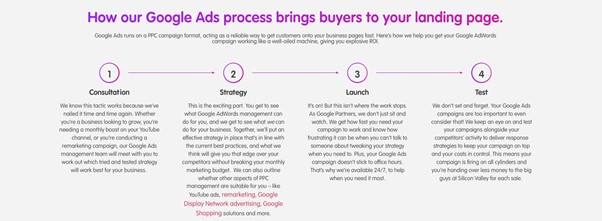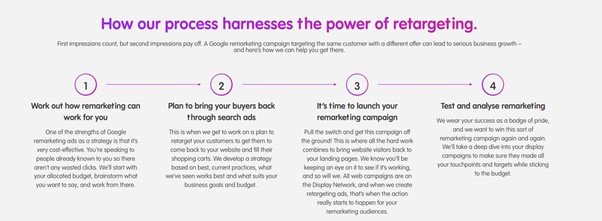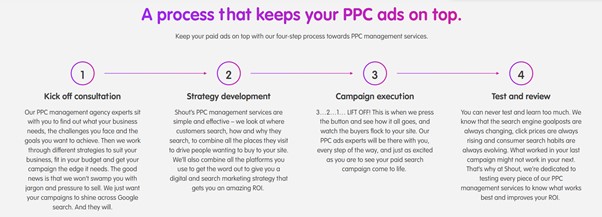Digital marketing has grown leaps and bounds over the last few years and pay-per-click campaigns are an excellent example of the growing digitization.
The ultimate idea behind internet marketing is that you pay for ads that have been clicked on. One has to only pay if their ads attract customers and generate leads. This makes it perfect for businesses of all sizes as it fits any marketing budget. Additionally, being search engine friendly adds to its growing popularity.
If you are considering building PPC marketing campaigns, you might need a little assistance. While this type of marketing does not require effort, it is always better to have a strategy in place.
Continue reading to learn more about how you can draw more attention to your landing pages with pay-per-click and search engine marketing.
What is PPC marketing?
It is an online marketing technique that reaches your target audience and attracts them to your website and landing pages. In this model, you do not reach out to your audience organically but instead, the advertiser pays for the ads that are being clicked on.
Search engine results pages are often full of pay-per-click advertising. Ad placement in search engines encourages more and more people to click on text ads. Every time someone clicks on your website link, you will be liable to pay a stipulated amount to the search engine. However, this amount is very nominal and generally results in leads for the business.
Improve your Google Ads PPC for eCommerce
Google ads are a type of pay-per-click ads that are very popular among small businesses. These are bid-based ads shown to users based on the keywords they enter.
Many factors go into figuring out which ad groups will be displayed on search engines. The search engine picks out the best ads from various ad groups and displays them.
One of the factors is the CPC or cost-per-click in a bid-based model, which is the amount advertisers pay for search engine advertising. The person with the maximum bid or the person willing to pay the most amount per click gets to display their ads to users. The cost per click varies from one search engine to another even if the user inputs the same search term.

Source
On the other hand, there is also a flat-rate model wherein you will be charged a fixed price for any type of search ads you want to be displayed. You can enter a high-value contract that mutually benefits you and the ad agencies equally.
What is PPC keyword research?
It is important to remember that your PPC campaigns rely on your keyword research. While building a list of relevant keywords it is important to know that you need to put in ample time and effort into this task.
It is important to continue doing keyword research as you progress with your campaigns. This way you will not miss out on anything in your keyword list and you will be able to rank higher on any search engine results page.
Here are 3 things that make a good keyword list for your PPC campaigns:
1. They should be relevant
Relevant content is the only thing that will help you get to your target market in PPC campaigns with Google ads. Apt keywords will result in a higher click-through rate in your ad campaigns. However, Google ads are also often displayed based on a negative keyword list.
2. They should be exhaustive
A majority of the searches online are going to be based on long-tail keywords. These lengthy keywords are very specific and having them on your list could be very beneficial for your search queries. Additionally, an exhaustive PPC keywords list will also help you get classified into better ad groups.
3. They should be expansive
Google analytics and google ads appreciate keyword lists that are regularly updated. If you want to get better with every pay-per-click campaign, then make sure you strengthen your search campaigns by upgrading your lists frequently. While adding relevant terms is crucial, you must also add negative keywords to expand your paid search.
Although it is important to make a keyword list that has all the keywords relevant to your brand, you must also think about the search intent of your customer.
Best ways to build a PPC strategy for eCommerce businesses
Focusing on your conversion rates might not be the best way to move forward with a pay-per-click model. If you want your ads to pop up at the top of search results then you must create PPC strategies for your business.
Here are a few tips to help you get started:
1. Figure out what you want
If you want to be successful with pay-per-click ads then the first step is to determine your goals. For example, you need to think beyond the call to action for the campaign.
Backtrack your customer’s steps to see what it takes to become a loyal customer of your brand. Do you want them to become long-term customers at your store, subscribe to your membership program, or purchase a larger ticket item? If yes, then you need to think like your customers and create strategies accordingly.
The best way to understand backtracking is to reverse-engineer the purchase path. This way you will know how leads move through your funnel to become loyal customers.
2. Look at things from the buyer’s perspective
The best way to explore the funnel is to re-evaluate the term itself. For this, you need to look at it from the buyers’ perspective.
For example, consider the keywords you use in a PPC campaign. Keywords can be used not only to find the right audience for your products but also to target your prospects in the right stage of the buyers’ journey.
The more specific the word, the more research a customer has already done before they find your services. This is why product-based searches show more intent to purchase at a sooner date.
Comparatively, a simple keyword search like bike shows the customer does not have enough information at the current moment to complete the purchase.
3. Remarketing
Part of the challenge with PPC advertising is you have one chance to get their attention. If you want to focus on conversions, you need to spend more time looking at how to capture prospects with a long-term goal.
Additionally, PPC advertising uses remarketing for a wide range of purposes. Remarketing helps because you can now get them to come back to your website by clicking on your ad and subsequently have them read your content, and even fill out forms. These micro-commitments are so small that a customer might not even notice what they are doing but subconsciously end up saying yes to your products when they are ready to buy.
This is why retargeting campaigns are such a valuable tool. It helps you stay in touch with all your prospects who might not have responded the first time they went through the process.
Just like in real life, where you cannot rush prospects through the process, the google ads interface too requires consistent change and evolution which only comes with remarketing. Remarketing allows you to play the long game with your customers, so they can buy when they feel comfortable which is the essence of digital marketing.
This strategy also improves the quality score of the ads, so the ads in the future shall cost less and get seen by a wider audience.

Source
4. Put it through tests
The best way to ensure you improve your conversions from a PPC model is to test what works and what does not. This means you should not only test the paid ads but also test the landing pages.
According to SEO Gadget, only 44% of companies currently use split testing to determine the conversion rate. However, if you are not testing the results of each step you will never know if you have the best conversion process. This will also not help you rank in organic listings.
It is important to remember that you are advised to do only A/B tests on a single element at a time. Therefore, if you want to determine how to improve your click rate, change the text or the image.
5. Align copy with landing pages
The next step is to make sure that the PPC ad leads directly to the landing page. You want your ad to match the landing page. It shows consistency to the prospect, and Google improves your quality score when you provide relevant content on the landing page that users appreciate.
One of the best ways to do this is to personalize your ads to your target market. This way they feel that every step from the PPC ad to the landing page to the conversion, matches people’s specific emotional appeals.
Tips for designing a PPC landing page
You can maximize conversions by building landing pages that cater to your customer’s every need. Ad clicks are excellent to move forward with your business. However, you need to work on your brand to convert leads and build brand loyalty. Here’s how you can do it:
1. Focus your landing page
The first key is to focus on a specific topic. Too many marketers send visitors to the home page or some generic services page. That way you lose conversions.
Your landing page needs to be a continuation of the PPC ad you displayed.
So, firstly, create a focused landing page with one objective. Squeeze pages are traditional examples of this type of marketing. Premium copy websites like CopyBlogger require you to sign up to their lists so you can access 20+ eBooks.
Secondly, e-commerce sites found success with category pages. These categories should be based on specific keywords.
2. Test your graphics and images
Another item you want to consider is testing the graphics and images you use for your landing page. Image positions and different types of graphics perform differently depending upon your industry.
3. Remove the navigation
A good way to reduce distractions so visitors stay on your landing page is to remove the navigation. While including the navigation does not decrease your QS, it distracts visitors while on your website.
4. Redirect old landing pages
The best PPC marketers have numerous landing pages. This is a smart strategy to test out which components of a site do best. The problem is that many landing pages are out of date. Avoid this by using 301 redirects to turn the visitor over to a working and updated landing page.
5. Social proof
Using reviews, recommendations, and testimonials boosts your trust factor with your audience. Online users trust reviews as much as a personal recommendation.
Therefore, you should display your testimonials on your landing page so that it catches the eye of your customers. Additionally, you can also strategize ad campaigns that promote your good reviews.
6. Detail and length
Consider the amount of detail and length you have for your landing page. If you have a technical audience, you need to have a very detailed landing page that is long and filled with content.
If you are selling products to busy entrepreneurs, then you need a 1-2 minute video and a short, concise landing page message for most viewers often are too busy to watch all of your content.
Making it quick and easy to increase your conversion rate.
7. Clear CTA
If your user has no clue how to sign up for your product or is looking around the Call to Action (CTA) they will probably just leave. So, your CTA must always be clear and succinct.
8. Mobile friendly
In today’s digital world e-commerce transactions happen on mobile devices. This means your PPC landing page needs to have a mobile component to reduce your costs and increase your lead generation.
B2B lead generation strategies
Business strategies are essential to take your business to the next level.
Therefore, we list a few lead generation strategies below so that you can implement them for your PPC ad campaigns.
1. UTM tracking
Before we dive into the deeper strategies, it is important to understand the value of UTM tracking. UTM tracking is the tiny snippets of code that make it possible for you to track the success of your campaign.
UTM codes track specific campaign parameters of your Google AdWords campaign that are added to the end of your landing page URL.
To create a UTM for your next campaign, you can use Google’s URL builder. Different UTM tracking codes help you understand different parts of your campaign and excel in online advertising.
2. Keywords
Once you created the UTM tags, you look for the highest converting keywords for your B2B PPC campaign. You can use tools like Google Keyword Planner or Ubersuggest to find the highest converting keywords for your campaign.
3. Personalize ads
Once you have your keywords, personalize your ads for specific segments of your campaign. This way your PPC ads have specific emotional appeal to those who need your services.
For example, if you sell business consulting services you may want to use separate ads for those who need your accounting services and those who could use your human resources management services.
While they both deal with business, they have very specific pain points. If you write a copy that is for both, it will sound robotic.
Instead, speak to people as human beings in your PPC ads, not as an advertising audience. This way they can experience how you care about their challenges in your ad copy.
4. Improve your quality score
By thinking about your Quality Score in advance, you can do things like improving your landing page to get visitors to stay longer or create more compelling ad copy to get additional clicks to your website.
Your Quality Score measures how many people click your ad, how long they stay on your website, as well as tracking other metrics to determine the quality of your ads.
The higher your Quality Score, the less pay you on Google AdWords.
5. Test your PPC ads
While you can test several different parameters in conjunction with each other, Kissmetrics points out in their Beginners Guide to AB Testing PPC, how four aspects govern an ad. These are:
- The headline
- The body text
- The link
- The keywords the ad displays for
Understanding these 4 elements allows you to test the key components of your campaign. One thing to keep in mind is that you will want to test early and often throughout your campaign.
You should also test specific elements one at a time to determine which elements impact the success of your ad the most.
6. Have an ad schedule
To ensure you stay on budget, have an ad schedule to provide a consistent schedule of results and expenses.
The more you schedule your ads to go out on specific days, the more you can track their importance in regards to the best performing B2B PPC ads.

To sum up
PPC advertising is one of the best and most affordable ways to market your brand online. If you are new to this, you can start with building a strategy and following through with it. Invest time in keyword research and find out what your targeted keywords are so you see the maximum results. Feel free to reach out to our PPC agency to learn how to build a successful PPC campaign.
